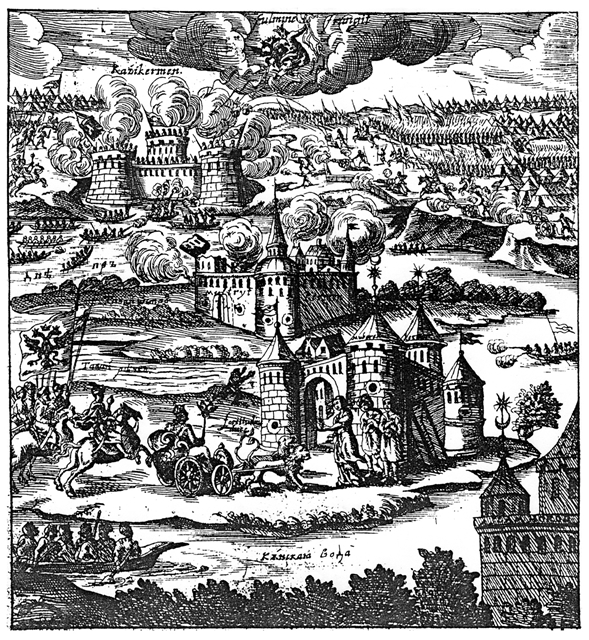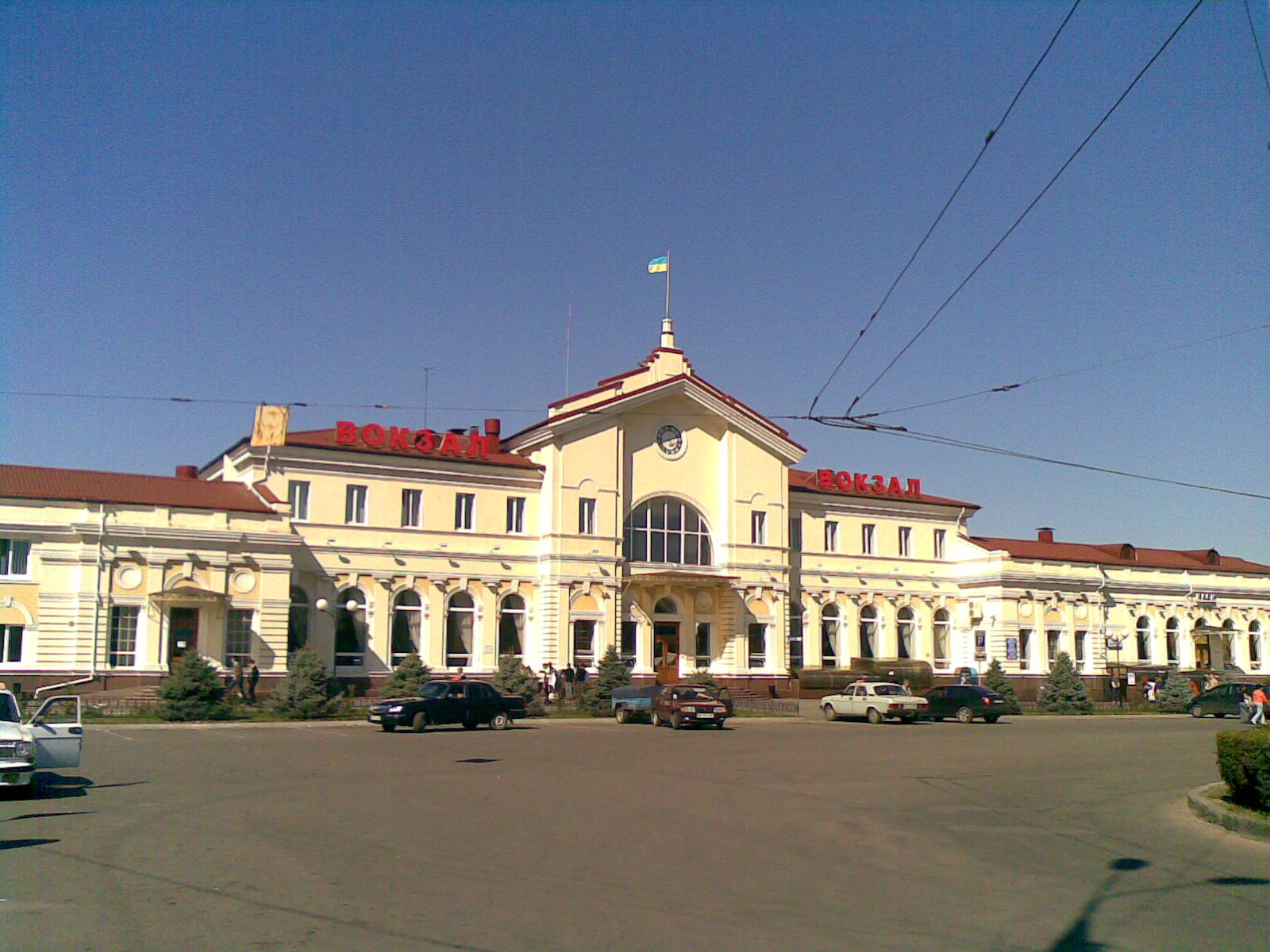|
1st Zadneprovsk Ukrainian Soviet Division
The 1st Zadneprovskaya Ukrainian Soviet Division was a military unit of the Ukrainian Soviet Army during the Russian Civil War. History Formation On January 26, 1919, a special detachment under the command of Pavel Dybenko, the commander of the 7th Sumy Regiment of the 2nd Ukrainian Soviet Division, captured the city of Katerynoslav during the offensive of the Ukrainian Front. The front was to continue its advance south. The position of the peasantry in the central and southern regions of Ukraine was of decisive importance in this situation. In addition the Katerynoslav railway was of strategic importance as it was the only one in the steppe Ukraine, and therefore the question of control over it was extremely acute. Local rebel groups were located just near this railway. On January 27, Dybenko and his chief of staff Sergey Ivanovich Petrikovsky were urgently summoned to Kharkiv by the commander of the Ukrainian Front, Vladimir Antonov-Ovseyenko. Antonov-Ovseenko ordered Dybe ... [...More Info...] [...Related Items...] OR: [Wikipedia] [Google] [Baidu] |
Red Army
The Workers' and Peasants' Red Army, often shortened to the Red Army, was the army and air force of the Russian Soviet Republic and, from 1922, the Soviet Union. The army was established in January 1918 by a decree of the Council of People's Commissars to oppose the military forces of the new nation's adversaries during the Russian Civil War, especially the various groups collectively known as the White Army. In February 1946, the Red Army (which embodied the main component of the Soviet Armed Forces alongside the Soviet Navy) was renamed the "Soviet Army". Following the dissolution of the Soviet Union it was split between the post-Soviet states, with its bulk becoming the Russian Ground Forces, commonly considered to be the successor of the Soviet Army. The Red Army provided the largest land warfare, ground force in the Allies of World War II, Allied victory in the European theatre of World War II, and its Soviet invasion of Manchuria, invasion of Manchuria assisted the un ... [...More Info...] [...Related Items...] OR: [Wikipedia] [Google] [Baidu] |
Northern Tavria
Kherson Oblast (, ; ), also known as Khersonshchyna (, ), is an oblast (province) in southern Ukraine. It is located just north of Crimea. Its administrative center is Kherson, on the northern or right bank of the Dnieper river, which bisects the oblast. The oblast has an area of 28,461 km2 and a population of It is considered the 'fruit basket' of the country, as much of its agricultural production is dispersed throughout the country, with production peaking during the summer months. Most of the area of the oblast has been under Russian military occupation since early in the 2022 Russian invasion of Ukraine. In September 2022, Russia claimed to have annexed Kherson Oblast after arranging a disputed referendum. The referendum and the subsequent claimed annexation are internationally unrecognized. As the result of a counteroffensive operation, Ukrainian forces retook the whole area on the right bank of the Dnieper, including Kherson city, by mid-November 2022. History ... [...More Info...] [...Related Items...] OR: [Wikipedia] [Google] [Baidu] |
Directorate Of Ukraine
The Directorate, or Directory () was a provisional collegiate revolutionary state committee of the Ukrainian People's Republic, initially formed on 13–14 November 1918 during a session of the Ukrainian National Union in rebellion against the Ukrainian State. During the Anti-Hetman Uprising it was named as the Executive Council of the State Affairs. Its authority was extended by the Labor Congress of Ukraine on 23–28 January 1919. After unsuccessful attempts to gather members of the committee, it dissolved on 10 November 1920. On 12 November 1920 by the Law on the Temporary Supreme Authority and the Legislative System of the UNR, the executive council was reformed into a single-person government position. Overview The Directorate was formed until a new council was to be elected to form the professional government. It was decided not to restore functioning of the Central Rada which was favored by the Ukrainian Socialist-Revolutionary Party, SR-centrists Mykhailo Hrushevsky ... [...More Info...] [...Related Items...] OR: [Wikipedia] [Google] [Baidu] |
Ukrainian People's Republic
The Ukrainian People's Republic (UPR) was a short-lived state in Eastern Europe. Prior to its proclamation, the Central Council of Ukraine was elected in March 1917 Ukraine after the Russian Revolution, as a result of the February Revolution, and in June, it First Universal of the Ukrainian Central Council, declared Ukrainian autonomy within Russia. Its autonomy was later recognized by the Russian Provisional Government. Following the October Revolution, the Central Council of Ukraine denounced the Bolsheviks, Bolshevik seizure of power and Third Universal of the Ukrainian Central Council, proclaimed the Ukrainian People's Republic with a territory including the area of approximately eight Russian imperial governorates (Kiev Governorate, Kiev, Volhynia Governorate, Volhynia, Kharkov Governorate, Kharkov, Kherson Governorate, Kherson, Yekaterinoslav Governorate, Yekaterinoslav, Poltava Governorate, Poltava, Chernigov Governorate, Chernigov and Podolia Governorate, Podolia). It F ... [...More Info...] [...Related Items...] OR: [Wikipedia] [Google] [Baidu] |
Ukrainian People's Army
The Ukrainian People's Army (), also known as the Ukrainian National Army (UNA) or by the derogatory term Petliurivtsi (, ), was the army of the Ukrainian People's Republic (1917–1921). They were often quickly reorganized units of the former Imperial Russian Army and newly formed volunteer detachments that later joined the national armed forces. The army lacked a certain degree of uniformity, adequate leadership to keep discipline and morale. Unlike the Ukrainian Galician Army, the Ukrainian People's Army did not manage to evolve a solid organizational structure, and consisted mostly of volunteer units, not Regular army, regulars. History Creation: Military congresses When the Tsentralna Rada () came to power in Ukraine in spring of 1917, it was forced to promptly put together an army to defend Ukraine against the Bolsheviks. Nearly all units of the newly created army were detached from the Imperial Russian Army. On March 29, 1917 the first organization of military forum the U ... [...More Info...] [...Related Items...] OR: [Wikipedia] [Google] [Baidu] |
Kherson
Kherson (Ukrainian language, Ukrainian and , , ) is a port city in southern Ukraine that serves as the administrative centre of Kherson Oblast. Located by the Black Sea and on the Dnieper, Dnieper River, Kherson is the home to a major ship-building industry and is a regional economic centre. At the beginning of 2022, its population was estimated at 279,131. From March to November 2022, the city was Russian occupation of Kherson Oblast, occupied by Russian forces during their Russian invasion of Ukraine, invasion of Ukraine. Armed forces of Ukraine, Ukrainian forces Liberation of Kherson, recaptured the city on 11 November 2022. In June 2023, the city was flooded following the Russian Destruction of the Kakhovka Dam, destruction of the nearby Kakhovka Dam. Etymology As the first new settlement in the Greek Plan, "Greek project" of Catherine the Great, Empress Catherine and her favourite Grigory Potemkin, it was named after the Heraclea Pontica, Heraclea Pontic colony of Cherson ... [...More Info...] [...Related Items...] OR: [Wikipedia] [Google] [Baidu] |
Volunteer Army
The Volunteer Army (; ), abbreviated to (), also known as the Southern White Army was a White Army active in South Russia during the Russian Civil War from 1917 to 1920. The Volunteer Army fought against Bolsheviks and the Makhnovists on the Southern Front and the Ukrainian War of Independence. On 8 January 1919, it was made part of the Armed Forces of South Russia, becoming the largest force of the White movement until it was merged with the Army of Wrangel in March 1920. History Formation The Volunteer Army began forming in November/December 1917 under the leadership of General Mikhail Alekseyev and General Lavr Kornilov in Novocherkassk, shortly after the Russian Civil War began following the October Revolution. It organized to fight against the Bolsheviks in South Russia. Alekseyev and Kornilov enlisted supporters, which initially included volunteering officers, cadets, students, and Cossacks. Of the first 3,000 recruits, only twelve were ordinary soldiers; the ... [...More Info...] [...Related Items...] OR: [Wikipedia] [Google] [Baidu] |
Vladimir May-Mayevsky
Vladimir Zenonovich May-Mayevsky KCMG (; – 30 November 1920) was a Russian military leader who was a general in the Imperial Russian Army and one of the leaders of the counterrevolutionary White movement during the Russian Civil War. Biography According to Peter Kenez, V. Z. Mai-Maevskii was a complex figure. He lived a dissolute life and his orgies brought ill-repute to the cause which he served. In territories under his control, terror and lawlessness reigned. His soldiers called him Kutuzov, not because of his style of leadership, but because of his appearance: he was fat and flabby and wore a pince-nez. He did not at all look like a soldier. Nevertheless, he was one of the ablest White military leaders." May-Mayevsky was born in 1867 to a family of minor gentry in Saint Petersburg. He entered military service in 1885, graduating from the Nikolaev Engineering Institute, serving as a lieutenant with the elite Izmailovsky Life Guards Regiment. He later graduated from ... [...More Info...] [...Related Items...] OR: [Wikipedia] [Google] [Baidu] |
Brigades
A brigade is a major tactical military formation that typically comprises three to six battalions plus supporting elements. It is roughly equivalent to an enlarged or reinforced regiment. Two or more brigades may constitute a division. Brigades formed into divisions are usually infantry or armored (sometimes referred to as combined arms brigades). In addition to combat units, they may include combat support units or sub-units, such as artillery and engineers, and logistic units. Historically, such brigades have been called brigade-groups. On operations, a brigade may comprise both organic elements and attached elements, including some temporarily attached for a specific task. Brigades may also be specialized and comprise battalions of a single branch, for example cavalry, mechanized, armored, artillery, air defence, aviation, engineers, signals or logistic. Some brigades are classified as independent or separate and operate independently from the traditional division str ... [...More Info...] [...Related Items...] OR: [Wikipedia] [Google] [Baidu] |
Regiments
A regiment is a military unit. Its role and size varies markedly, depending on the country, service, or specialisation. In Medieval Europe, the term "regiment" denoted any large body of front-line soldiers, recruited or conscripted in one geographical area, by a leader who was often also the feudal lord ''in capite'' of the soldiers. Lesser barons of knightly rank could be expected to muster or hire a company or battalion from their manorial estate. By the end of the 17th century, infantry regiments in most European armies were permanent units, with approximately 800 men and commanded by a colonel. Definitions During the modern era, the word "regiment" – much like "corps" – may have two somewhat divergent meanings, which refer to two distinct roles: # a front-line military formation; or # an administrative or ceremonial unit. In many armies, the first role has been assumed by independent battalions, battlegroups, task forces, brigades and other, similarly sized oper ... [...More Info...] [...Related Items...] OR: [Wikipedia] [Google] [Baidu] |
Yenakiieve
Yenakiieve (, ; ) is a city and the nominal administrative center of Yenakiieve urban hromada in the Horlivka Raion, Donetsk Oblast of Ukraine. The city stands on the Krynka River about from the oblast's administrative center, Donetsk. Its population is approximately Yenakiieve is an important regional centre of coal mining, metallurgy, chemical industry, chemical production and manufacturing. The city's outdated industry has caused accidents like that of a 2008 Ukraine coal mine collapse, gas explosion which occurred in June 2008 at one of Yenakiieve's coal mines. Yenakiieve was founded in 1898 when numerous workers' settlements around the Peter's Iron and Steel Works were united into a single settlement named after . Its first coal mines dated from 1883. The settlement was incorporated as a city in 1925. By 1958, the city and factories had expanded significantly and overtook the outlying villages of Simyukuo, Yevrah, and Tsiminyenny, all of which were resettled in their ent ... [...More Info...] [...Related Items...] OR: [Wikipedia] [Google] [Baidu] |




